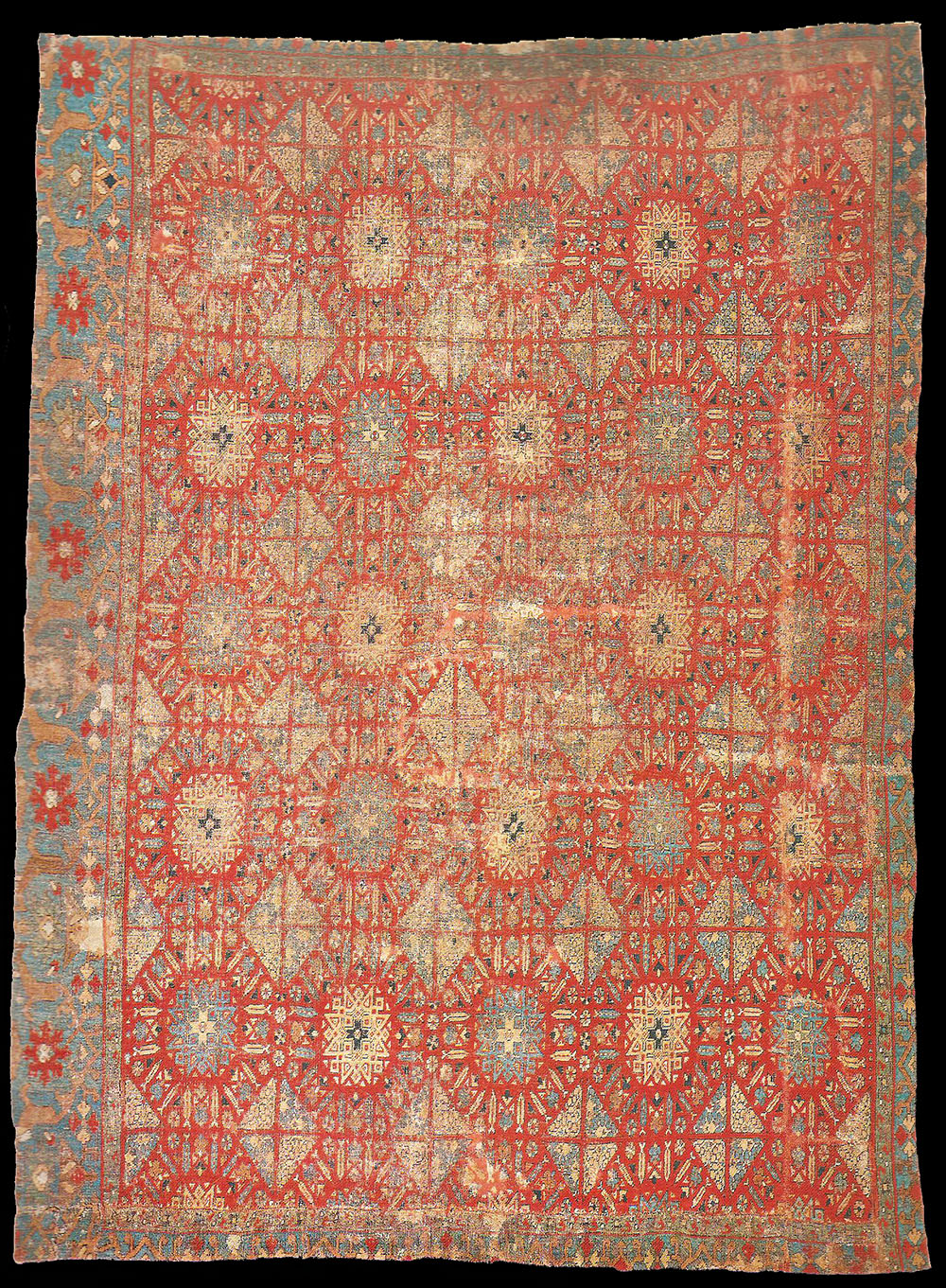|
A COMPARTMENT CARPET
PROBABLY DAMASCUS, SYRIA, SECOND HALF 16TH CENTURY
Price Realized £43,700 ($86,220)
Sale Information
Christie's SALE 7572 —
ORIENTAL RUGS AND CARPETS
10 April 2008
London, King Street
Lot Description
A
COMPARTMENT CARPET
PROBABLY DAMASCUS, SYRIA, SECOND HALF 16TH CENTURY
Reduced in length, old repaired cuts, losses to border, light wear,
corroded black, small cobbled repairs, backed
8ft.11in. x 6ft.6in.
(271cm. x 198cm.)
Warp: wool, ivory, Z2S
Weft: wool, pink, Z1; 2
shoots
Pile: wool, Z2S; assymetric open to the left, deep depression;
H42 x V27
Special Notice
No VAT will be charged on the hammer price,
but VAT at 15% will be added to the buyer's premium which is invoiced on a
VAT inclusive basis.
Provenance
Lefevre, London, 6 October 1978, lot 39
with J. Eskenazi, Milan.
Literature
J. Eskenazi, and M. Franses, Il Tappeto Orientale
dal XV al XVIII Secolo, London, 1981, no.3, pp.24-5, ill.p.68.
Volkmar
Gantzhorn, The Christian Oriental Carpet, Köln, 1991, ill.322,p.209.
Christopher Alexander, A Foreshadowing of 21st Century Art, New York and
Oxford, 1993, pp.242-245.
Lot Notes
The attribution of the
'compartment' rugs to Syria is one that dates back a considerable time. In
1909 Konsul Bernheimer bought his example (sold in these Rooms 14 February
1996, lot 27) as an "alter syrische Teppich". Yet this attribution is far
from certain. While the group has a clear homogeneity within itself, its
combination of technical structure and design motifs makes it difficult to
place. Egypt, Rhodes, the Adana plain and East Anatolia have all been
proposed. The subject is discussed at length in various places, the
fullest of which are Robert Pinner, and Michael Franses, 'The Eastern
Mediterranean Carpet Collection in the Victoria and Albert Museum', Hali
vol.4, no.1, pp.37-52; and Friederich Spuhler, ''Chessboard' Rugs', in
Robert Pinner and Walter Denny, Oriental Carpet and Textile Studies II,
London, 1986, pp.261-269.
Few of these carpets have survived,
indicating a small production; it is therefore not surprising that few are
found depicted in European paintings. The earliest sight of one in Europe
is shown not in a painting but a tapestry of the mid 16th century
reproduced in Eskenazi and Franses (op.cit., fig.8, p.25). In the field of
paintings the first is shown in a painting by Marco dall'Angelo dateable
to before 1581, the design continuing to be found into the middle of the
following century (John Mills, 'East Mediterranean Carpets in Western
Paintings', Hali vol.4, no.1, pp.53-55).
Spuhler notes that "only
29 pieces with a consistent chessboard design" are known, almost half of
which have an identical border. All the smaller examples share this border
of cartouches alternating with cusped lozenge panels, as do a few of those
with more than six medallions. Only the larger carpets display a variety
of border designs with that seen on the present carpet also visible on the
example in the Berlin Museum (Friederich Spuhler, Oriental Carpets in the
Museum of Islamic Art, Berlin, London, 1988, no.71, ill.p.214) and on one
formerly in the Pharaon Collection and sold in these Rooms 11 October
1990, lot 17, the latter having a sage-green ground to the border. It is
also interestingly the same border as is found on a carpet which is
crucial to the placing of the group, that formerly in the Campana
Collection whose field design is centralised around a large octagon in the
Mamluk manner, but whose design elements are similar to those seen here
(Gantzhorn, op. cit.: ill.325, p.212; Jon Thompson, Milestones in the
History of Carpets, Milan, 2006, pl.121, p.140). The same border is also
used on the rug of this group in Cairo whose design appears to show the
influence of an earlier Anatolian model (Belkis Balpinar and Udo Hirsch,
Carpets: Vakiflar Museum, Istanbul, Wesel, 1988, no.1, pp.34-39,
ill.p.179).
While all the rugs with this structure and field
design, in its slight permutations, display an alternation between the
colours of the medallions, the present example makes this a much more
prominent feature of the design. While the two colours involved in most
are a blue-green alternating with a soft green (see for example the
magnificent carpet sold in these Rooms 17 October 1996, lot 417 or the
Berlin piece mentioned above), this rug uses a far lighter and clearer
blue coupled with an off-white, bringing a brighter and fresher look to
the palette. The same light blue in the border is again clearer and
fresher than that which is normally encountered.
|

